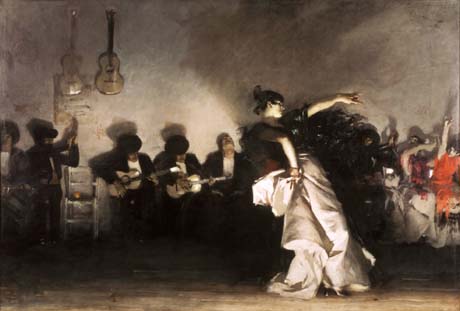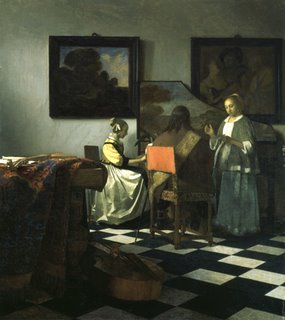Afternoon at the Gardner
 The Isabella Stewart Gardner Museum is one of my favorite places in Boston. From the outside it doesn't look very promising - a blocky building of tan brick - and so it's especially dazzling once you step inside and discover you've entered a Venetian palazzo, complete with its own glass-roofed courtyard.
The Isabella Stewart Gardner Museum is one of my favorite places in Boston. From the outside it doesn't look very promising - a blocky building of tan brick - and so it's especially dazzling once you step inside and discover you've entered a Venetian palazzo, complete with its own glass-roofed courtyard.I had always been under the impression that the building started out as Mrs. Gardner's private home, and I enjoyed imagining her getting up in the night for a glass of milk, creeping in a white nightgown through four stories of gloomy, tapestry-hung galleries. It made more sense once I did my research and learned that she had the structure built with the intention of opening a museum, and only ever inhabited private rooms on the fourth floor. (I still like to picture her using the opulent, archaic museum rooms for her private amusement though, after hours, like an overgrown Claudia Kincaid from the beloved "Mixed-Up Files of Mrs. Basil E. Frankweiler." She reminds me a bit of Mrs. Frankweiler, too, come to think of it.)
My mother liked to tell me that she first took me to the Gardner when I was a baby and we were visiting friends in Boston. She said she lugged me all around the museum without a carrier, and by the end of the day her arms were killing her. Something must have sunk into my infant brain that day, because I've always been drawn back there over the years. It's not so much about the art, though there are a few paintings I do love, but the extravagent atmosphere of the place itself. It's like a day-trip to Europe and the past for a $10 ticket, plus T fare.
El Jaleo, 1882, John Singer Sargent

I visited to the Gardner many times when I was in college, particularly after I returned from a JYA stay in England and was feeling deprived of the Old World splendors I'd taken for granted the previous year. But I hadn't been back since then, so we headed over there one rainy Sunday a few weeks ago to see if it still held its old magic.
Isabella Stewart Gardner in Venice, 1894, Anders Zorn

Doesn't she look like she's having a great time in this portrait? The story goes that she had just stepped onto the balcony to watch a display of fireworks, then turned back to her friends and said, "Come out - all of you - this is too beautiful to miss!"
Over the main door of the museum is a seal that bears the phrase, "C'est mon plaisir" (It's my pleasure). What a gracious way to welcome the public into your own personal treasure trove. In the public restrooms, various tiles are emblazoned with some of her favorite mottos. "Win as though you were used to it, and lose as if you like it." According to the museum's web site, she is also quoted as saying, "Don't spoil a good story by telling the truth."
Anyone with the first name "Isabella" is admitted free to the museum, "forever." Sorry, Isabelles and Isabels, "other variations and spellings do not apply."
The Concert, Vermeer
 The museum was famously robbed in 1980. Two thieves dressed as Boston police officers stole 13 pieces of art, including paintings by Vermeer and Rembrandt, and none of these works was ever recovered. (If you happen to stumble across any of them "in good condition," there's a $5 million reward waiting for you.) There are still blank spaces on the walls where they used to be, each with a little note explaining what was stolen.
The museum was famously robbed in 1980. Two thieves dressed as Boston police officers stole 13 pieces of art, including paintings by Vermeer and Rembrandt, and none of these works was ever recovered. (If you happen to stumble across any of them "in good condition," there's a $5 million reward waiting for you.) There are still blank spaces on the walls where they used to be, each with a little note explaining what was stolen.You can't help but wonder where they might be. Hanging in the private study of an unscrupulous billionaire? Collecting dust in a barn somewhere? Also, why those particular 13 pieces? The Vermeer, the Rembrandts - I can see why they would be at the top of the list. But why not the other Rembrandts at the museum? Did the thieves run out of time? Why the French flag finial shaped like an eagle? Was it just easy to grab? Was it by someone's specific request? If so, Degas collectors might want to watch their backs; five of the thirteen stolen pieces were signed with his name.
It was really dark in the museum the day we were there. All the windows were covered with pale linen shades, presumably to protect the art from light damage, but with the gloomy rain outside there was barely enough light to see. Museumgoers were huddled close to each picture or tapestry or vase, eyes squinted as they tried to make out the details. Several rooms were under renovation, with big sheets of black plastic covering their doors. One end of the Tapestry Room, a long, wide hall used for concerts, was roped off and piled with chairs, chests, and silver candlesticks, like some kind of grand dutchess's yard sale. "Antique thrones, cheap!"
Omnibus, 1892, Anders Zorn
 We stopped in one last gallery, the dimmest of all, on our way to pick up our coats and umbrellas, and I saw a painting I hadn't noticed on previous visits that I think was my favorite of the day. It echoed the mood of the blustery weather outdoors and the gray light within, and made me feel that as different as the clothes were all those years ago, the people in the painting weren't that different from us, riding the bus to get somewhere, sitting next to strangers and staring into space.
We stopped in one last gallery, the dimmest of all, on our way to pick up our coats and umbrellas, and I saw a painting I hadn't noticed on previous visits that I think was my favorite of the day. It echoed the mood of the blustery weather outdoors and the gray light within, and made me feel that as different as the clothes were all those years ago, the people in the painting weren't that different from us, riding the bus to get somewhere, sitting next to strangers and staring into space.And then we went out into the rain, but instead of getting on a bus ourselves, we walked all the way home, through the Fens and across the river, back through Central Square and into the modern world again.

4 Comments:
very lovely writing...just like its author!
I echo the sentiments of the previous commentator. Lovely writing indeed that inspires me to finally visit the museum that's always on my to-do list. I, too, was under the impression that the building was, at some point, in some incarnation, her private home. Doesn't everyone live like that?
Excellent post! The Gardner is really the best museum in which to spend an afternoon with the Somervillain....
nice post! I visited the Portland Art Museum recently on a rainy Saturday, and there was a fantastic exhibit of photographs by William B. Post, all taken around 1900. Platinum prints, mostly of cherry blossoms, or snowy farm fields, there were some striking photos of people: two friends strolling on the beach in their white dresses, corseted and laced up to their necks; an overdressed woman rowing a boat. It was astonishing to feel that connection with those people from 100 years ago. Despite the difference in dress, we are essentially drawn to the same things. The photographs made them all the more real.
Post a Comment
<< Home